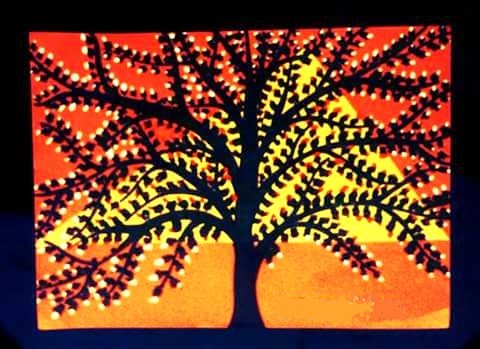
[This piece of article is provided by Ms. SONAM DHINGRA who is a prominent art teacher at City Vocational Public School, Meerut, by profession and an artist herself. She has done in-depth research on indian arts and crafts.]
During the period 1966-68, a prolonged drought struck Madhubani and the neighbouring region of Mithila. In order to create a new source of non-agricultural income, the All-India Handicrafts Board encouraged the women entrepreneurs to produce their traditional paintings on handmade paper for commercial sale. For the market, the work is done on handmade paper or cloth treated with cow dung to give it its distinctive look and identity. Ever since, this craft has become a regular source of income for thousands of women in Mithila. The women entrepreneurs travel far and wide and sell their work through art exhibitions.
Since then, painting has become a primary source of income for scores of families in Mithila. Production and initial marketing have been regulated by regional craft guilds, the state government of Bihar, and the Government of India. But the continuing market in this art throughout the world is a tribute to the resourcefulness of the women of Mithila who have successfully transferred their techniques of bhitti chitra or wall-painting to the medium of paper, and have resisted the temptation to adapt their traditional designs too freely in pursuit of unpredictable public tastes. And, more to the point, it has created a new source of gainful employment in rural Bihar for women and their families.
In the late 1960s and 1970s, with the growth of painting on paper for sale, women began earning incomes which were previously unimaginable. In many cases they were able to retain that income, and use it for the schooling of their daughters and better food and clothing for their children or themselves. For many it was an empowering experience. And at least in some cases, the families of young women who were talented painters did not have to pay, or pay as much, dowry when they were getting married. Well known painters also were invited to travel to fairs and exhibitions elsewhere in India, as well as internationally to Japan, Europe, the United States and Russia. They usually brought a son or husband along to assist them, but success in painting meant both new income and greater social status and mobility.
Today this art has been exposed to the whole world. Its market value has been increasing day by day. It has also been modernized due to the concept of globalization. The women painters are not applying their indigenous knowledge only in the four walls of their houses but they are exposed to the outside world. Now-a-days, Mithila paintings are depicted on handmade papers and clothes by modern brushes and acrylic colours. They are also very sentimental towards their daily life activities, fairs and festivals, rites and rituals. They want to capture unforgettable moments of rituals, festival and social life.
"Ritual ceremonies, cycles of seasons, fairs and festivals lent an additional colour and richness to their otherwise drab lines. The day to day swinging community life enjoyed by the rural folk as well as their tribal Kinsmen goes a long way to render their lives meaningful by filling them with laughter, gaiety, cheerfulness- all these factors have a definite bearing on all their creations, be it painting, image-making, singing or dancing."(Aryan, 2010)
